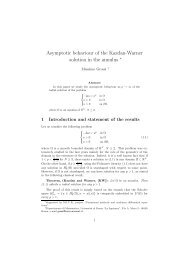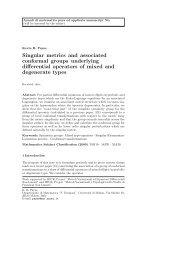Degree of Parabolic Quantum Groups - Dipartimento di Matematica ...
Degree of Parabolic Quantum Groups - Dipartimento di Matematica ...
Degree of Parabolic Quantum Groups - Dipartimento di Matematica ...
You also want an ePaper? Increase the reach of your titles
YUMPU automatically turns print PDFs into web optimized ePapers that Google loves.
5. <strong>Quantum</strong> universal enveloping algebras for parabolic Lie algebras 53<br />
Property. (i) If i ∈ Π l , then<br />
for some s ∈ {1, . . .,h}.<br />
(ii) If i ∈ Π \ Π l , then<br />
for some s ∈ {1, . . .,k}.<br />
Ei = E β 1 s ,<br />
Fi = F β 1 s .<br />
Ei = E β 2 s ,<br />
Fi = F β 2 s .<br />
Definition 5.1.1. The simple connected quantum group associated to p, or<br />
parabolic quantum group, is the C(q) subalgebra <strong>of</strong> U(g) generated by<br />
U(p) = 〈E β 1 i , Kλ, Fβj 〉<br />
for i = 1, . . .,h, j = 1...N and λ ∈ Λ.<br />
Definition 5.1.2. 1. The quantum Levi factor <strong>of</strong> U(p) is the subalgebra<br />
generated by<br />
U(l) = 〈E β 1 i , Kλ, F β 1 i 〉<br />
for i = 1, . . .,h, and λ ∈ Λ.<br />
2. The quantum unipotent part <strong>of</strong> U(p) is the subalgebra generated by<br />
with s = 1...h<br />
U w = 〈F β 2 s 〉<br />
Set U + (p) = U + (l) = 〈Ei〉 i∈Π l, U − (p) = 〈Fi〉i∈Π, U − (l) = 〈Fi〉 i∈Π l and<br />
U 0 (p) = U 0 (l) = 〈Kλ〉λ∈Λ. We have:<br />
Property. The definition <strong>of</strong> U(p) and U(l) is independent <strong>of</strong> the choice <strong>of</strong><br />
the reduced expression <strong>of</strong> wl 0 and w0.<br />
Pro<strong>of</strong>. Follows imme<strong>di</strong>ately from proposition 4.1.5.<br />
We can now state the P.B.W theorem for U(p) and U(l), which is an<br />
imme<strong>di</strong>ately consequence <strong>of</strong> 5.1.<br />
Proposition 5.1.3. (i) The monomials<br />
E s1<br />
β 1 1<br />
· · ·E sh<br />
β1KλF h<br />
tk+h<br />
β1 h<br />
· · ·F tk+1<br />
β1 F<br />
1<br />
tk<br />
β2 · · ·F<br />
k<br />
t1<br />
β2 1<br />
for (s1, · · · , sh) ∈ (Z + ) h , (t1, . . .,tN) ∈ (Z + ) N and λ ∈ Λ, form a C(q)<br />
basis <strong>of</strong> U(p).








